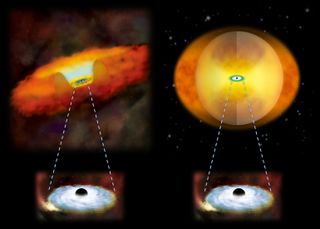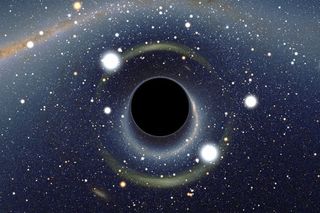Gas-and-Dust Cocoon Engulfs Monster Black Holes When Galaxies Collide

When galaxies collide, massive amounts of gas and dust create a cocoon of debris around the ravenous black hole at the center of the merger, a new study shows.
Using NASA's Nuclear Spectroscopic Telescope Array (NuSTAR), astronomers studied several merging galaxies to show that such large-scale interactions can greatly disrupt material orbiting in the vicinity, ultimately accelerating the rate at which the material falls in toward the center of the black hole and creating what is known as an active galactic nucleus (AGN).
This process forms a thick sphere of dust and gas around the black hole of a galaxy merger, rather than the doughnut-shaped cloud that surrounds a supermassive black hole in a normal galaxy, according to a statement from NASA. [When Galaxies Collide: Photos of Great Galactic Crashes]
"A supermassive black hole grows rapidly during these mergers," Claudio Ricci, lead author of the study, said in the statement. "The results further our understanding of the mysterious origins of the relationship between a black hole and its host galaxy."
For the study, the researchers examined 52 supermassive black holes in nearby merging galaxies. As material is funneled in toward a central black hole, it releases high-energy X-ray emissions. However, the thick cloud of gas and dust surrounding the black hole of a galaxy merger can completely obscure such emissions, the researchers said.
NASA's NuSTAR X-ray telescope, however, is sensitive to high-energy X-rays and therefore able to detect emissions that escape the thick cloud of debris. The researchers compared NuSTAR data with observations from NASA's Swift and Chandra and the European Space Agency's XMM-Newton observatories, which look at lower energy components of the X-ray spectrum, according to the NASA statement.

The measurements suggest that when high-energy X-rays are detected and low-energy X-rays are not, the AGN is surrounded by a shell of thick material fueled by the collision of galaxies. Furthermore, during the later stages of this process, the black hole in a merging galaxy is almost completely obscured by a cloud of debris, the researchers said.
Get the Space.com Newsletter
Breaking space news, the latest updates on rocket launches, skywatching events and more!
"The further along the merger is, the more enshrouded the AGN will be," Ricci said in the statement. "Galaxies that are far along in the merging process are completely covered in a cocoon of gas and dust."
Their findings, published Jan. 23 in the journal Monthly Notices of the Royal Astronomical Society, support the idea that “an AGN's black hole does most of its eating while enshrouded during the late stages of a merger,” the researchers said.
Follow Samantha Mathewson @Sam_Ashley13. Follow us @Spacedotcom,Facebook and Google+. Original article on Space.com.
Join our Space Forums to keep talking space on the latest missions, night sky and more! And if you have a news tip, correction or comment, let us know at: community@space.com.

Samantha Mathewson joined Space.com as an intern in the summer of 2016. She received a B.A. in Journalism and Environmental Science at the University of New Haven, in Connecticut. Previously, her work has been published in Nature World News. When not writing or reading about science, Samantha enjoys traveling to new places and taking photos! You can follow her on Twitter @Sam_Ashley13.
